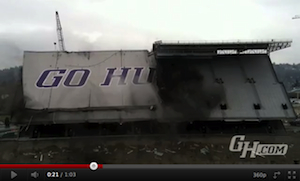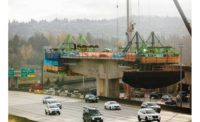
A video of Seattle's Husky Stadium roof demolition went viral on the web as fans clamored to get a look at the start of major renovations at the famed 90-year-old structure. But a near miss captured in that same video also got the attention of the Washington State Dept. of Labor and Industries, launching an investigation into the operation of a crane there.
The video clearly shows a massive jarring, or shock-loading, to a crane while the east portion of the roof was demolished, the result of a large cutting device getting caught up in the roof's steel girders. While no one was injured, the crane was badly damaged, and L&I wants to check on the procedures in place during the demolition, says Hector Castro, a spokesman for the agency.
Investigations have been launched into Seattle-based Ness & Campbell Crane; Rhine Demolition, Tacoma, Wash.; demolition engineer Roberts Engineering, Redmond, Wash., and the job's general contractor, New York City-based Turner Construction. The stadium site is on the Seattle campus of the University of Washington.
While removing the roof overhang on the 72,000-seat stadium as part of a $250 million renovation, crews were using a 1989 Link Belt 250-ton lattice-boom crane rigged with 230 ft of boom. It was holding nippers to snip five overhang supports. A separate crane was holding the hydraulic hoses for the nipper as well as someone in a backhoe operated the device, Castro says. Crews already had successfully cut three overhangs and were working on the fourth when the roof began to buckle and started to collapse.
"They weren't able to release in time to prevent the nipper from being yanked downward," Castro says. "So that is where we see a sudden shock and motion."
The crane was damaged during the Tuesday, Dec. 20, event and pulled from service. Under Washington's two-year-old crane certification program, L&I yanked the crane's certification the following day. "In Washington state, all construction cranes have to be certified to be operated," Castro says. "They can't use that crane until it gets recertified."



Post a comment to this article
Report Abusive Comment